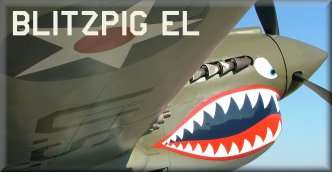
 |
|
|||||||
| IL-2 Sturmovik The famous combat flight simulator. |
 |
|
|
Thread Tools | Display Modes |
|
#31
|
|||
|
|||
|
Quote:
On the other hand, the P40 (both Hawk 81 and 87) should not even come close to the Spitfire's turn rate and radius. Wing loading is significantly higher, no Spitfire until the MkXIV exceeds it, and the power to weight ratio is lower than any Spitfire (some of the higher power late model P40s have a slightly higher power to weight ratio than the Spitfire MkI and MkII). |
|
#32
|
|||
|
|||
|
I consider it a pretty poor response to respond to a question with another question instead of with an answer. But I did not expect anything else from you.
Soviet VVS turning tests show the Spitfire and P-40 turning to be on par, Spitfire models at 17.5 to 18.8 seconds, P-40 models at 18 to 19.2 seconds. Can't provide a link to an actual test report. NACA 868 roll rate chart has the Spitfire with a higher rate of roll at low speeds. NACA wartime reports have the Spitfire achieve higher roll rate at low speeds. Both refer to full span wing, and likely metal ailerons for the Spitfire. You can download all NACA wartime reports from here. You can also order this study from the UK National Archives, it has a direct comparison. It's also available here as a pdf. It again shows the Spitfire to achieve a superior rate of roll at low speeds. And now? You want to back up your claims for once? Or will you be defaulting back to your usual insult and denial routines? I'm expecting no less, please disappoint me. Last edited by JtD; 02-06-2011 at 05:38 PM. |
|
#33
|
|||
|
|||
|
El... was it not the Hawk/P-36 that had the fantastic sustained turn rate and the P-40 had some degradation of this capability?
__________________
Find my missions and much more at Mission4Today.com |
|
#34
|
||||
|
||||
|
Clearly someting is amiss here.
Hawk 81s had a roll rate of 135 degrees per second at 360mph IAS. The Hawk 87s (test done on P40F) were down to 95. Data from Amercia's Hundred Thousand by Francis H. Dean.
__________________
 Personally speaking, the P-40 could contend on an equal footing with all the types of Messerschmitts, almost to the end of 1943. ~Nikolay Gerasimovitch Golodnikov |
|
#35
|
||||
|
||||
|
This may be correct, as the Hawk 75 was considerably lighter than the Hawk 81.
__________________
 Personally speaking, the P-40 could contend on an equal footing with all the types of Messerschmitts, almost to the end of 1943. ~Nikolay Gerasimovitch Golodnikov |
|
#36
|
|||
|
|||
|
One number on one plane is all you got?
That's insufficient to make a statement about the relative performance of two aspects of two planes. |
|
#37
|
||||
|
||||
|
Sorry JTD, but it's been years, decades even, since I've read some of this stuff.
I do know that the Curtiss Hawks, 75, 81, and 87 were very maneuverable aircraft. Much more so than they are portrayed in the current popular aviation culture. And I stopped being a rivet counting chart monkey a long time ago. It just got old. Nothing personal JTD. Life is contentious enough without instigating slag fests on internet forums.
__________________
 Personally speaking, the P-40 could contend on an equal footing with all the types of Messerschmitts, almost to the end of 1943. ~Nikolay Gerasimovitch Golodnikov |
|
#38
|
|||
|
|||
|
Then why don't you state just that:
There'd be nothing to argue about. |
 |
|
|